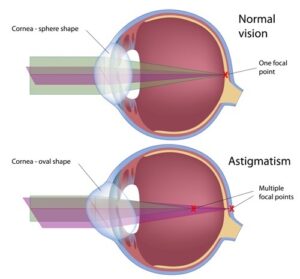Having cataract surgery involves removing your cataracts. The only way to do this is by removing the natural lens in the eye.
The natural lens is where a cataract forms, making it necessary to remove it. But when you remove the natural lens, it leaves you unable to see clearly.
That’s where an intraocular lens comes in. Intraocular lenses, or IOLs, are artificial lenses that help patients see clearly after cataract surgery.
There are a lot of choices when it comes to IOLs. Some patients may struggle to try to choose the right IOL.
But one thing to consider is your lifestyle and visual goals after cataract surgery. Keep reading to learn how to choose the best intraocular lens for your lifestyle before having cataract surgery!
Standard IOLs Vs. Premium IOLs
A standard cataract procedure is usually covered by health insurance. Cataract surgery is medically necessary because it ensures patients keep their vision.
Monofocal IOLs

However, only one kind of intraocular lens is covered by insurance when you have cataract surgery. This is a monofocal IOL.
Monofocal lenses are uniform lenses all over the lens. They can help patients see either up close or far away. You’ll need to use glasses to see at other distances, including intermediate ranges.
Monovision
Another less talked about option is monovision. With monovision, you’ll have a monofocal lens placed in your eye to help you see up close, and then the other lens will help you see at a distance.
Patients can see well enough when they look up close or at things further away. However, you won’t be able to see well at intermediate distances, and it doesn’t provide you with crisp vision at a wide range of distances. It can also be challenging for some patients to get used to, making it unsuitable for everyone.
Premium IOLs
Premium IOLs, on the other hand, are often designed to reduce or eliminate the need for other visual aids like reading glasses. You will have to pay out of pocket for premium lenses because insurance will not cover them.
However, many patients find the extra cost well worth it. Premium IOLs can improve your vision. They may even provide you with better sight than you had before cataracts.
There are several kinds of premium IOLs to choose from, though, and finding the best one for you may still be tricky. But with these tips, you can narrow down your choices.
Determine Your Budget

The first thing you should do is decide how much you’re willing to spend. Monofocal lenses are covered by insurance, meaning you won’t have to pay out of pocket for them. If you’re more budget conscious, these may be the best choice.
They will save you money, but you may still require glasses to see most of the time. Premium IOLs are an out-of-pocket expense, but they provide you with less dependence on visual aids.
Make sure to talk to your eye doctor to determine the cost and what you can afford within your budget. Take your visual needs and the way you want to see after cataract surgery into account as well.
Think About Your Daily Needs

Everyone has different tasks they perform daily. Someone who works on a computer all day has different visual needs than someone who works on a construction site.
When looking at your IOL options, think about how you use your sight the most. Do you need to see things right in front of you a lot?
Do you need to be able to switch between seeing at different distances quickly? Different IOLs can help you see various ranges. Choose the one that will best suit your daily needs.
How Do You Feel About Reading Glasses?

Many premium IOLs are designed to correct presbyopia. Presbyopia is an age-related eye condition that occurs when the natural lens loses flexibility.
Most people over 45 have some degree of presbyopia, and many need reading glasses to see up close. Premium IOLs are often designed to reduce or eliminate the need for reading glasses.
Some even reduce the need for regular glasses and contact lenses. If you’re okay with using reading glasses regularly, you may not need a premium IOL.
But if you want to reduce your dependence on reading glasses or no longer need them, a premium IOL is worth considering as your best option.
Do You Have Astigmatism?

If you have astigmatism and want to correct it during cataract surgery, there’s a certain kind of IOL that may be perfect for you. A toric lens is designed specifically to correct mild astigmatism, usually up to 3.00 D.
Toric lenses are the only IOLs specifically designed to correct astigmatism. Patients with astigmatism can correct their refractive error while removing their cataracts.
Most toric models are available in other premium IOLs so that you can correct other refractive errors and presbyopia in many cases.
Consult with Your Ophthalmologist

The most important thing to do when deciding on an IOL is to talk to your eye doctor. They can recommend the best IOL for you based on your visual goals and lifestyle needs.
Together, you can decide on the best one based on your visual goals, lifestyle needs, and budgetary restrictions. Your ophthalmologist can give you more information about how each IOL works and help you fully understand each choice.
Before you can have cataract surgery, you need to know what your goals are after cataract surgery. A solid foundation of trust and communication with your eye doctor will ensure you choose the right intraocular lens and achieve the vision you want after cataract surgery.
Are you ready to learn more about IOLs and which one may be right for you? Request an appointment at New England Eye Center in Boston, MA, today! Isn’t it time to see clearly after cataracts?




